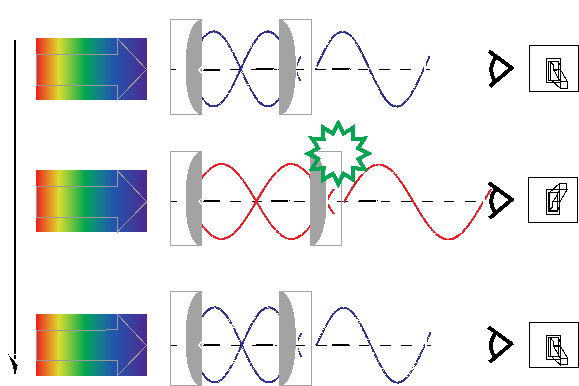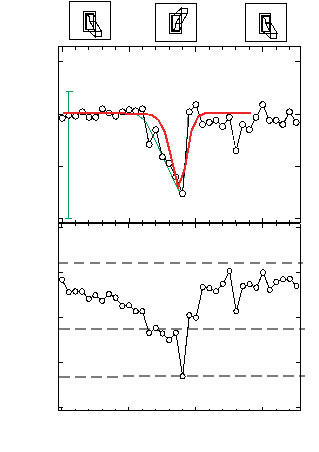| Apr 29, 2011 |
The fastest optical switch in the universe
|
|
(Nanowerk News) Switches are devices that are omnipresent in computers as they are crucial to manipulate information encoded as bits. To greatly improve the speed with which information is processed, much work is being done worldwide to realize optical switches that control information encoded as light pulses. To date, the speed of optical switches is limited by the properties of the underlying materials, but not by the speed of light.
|
|
Now scientists from the MESA+ Institute for Nanotechnology at the University of Twente and the FOM-Institute Amolf in Amsterdam in the Netherlands, and the Institute for Nanoscience and Cryogenics (CEA/INAC) in Grenoble in France have managed to switch-on and switch-off a semiconductor optical cavity within a world-record short time of less than 1 picosecond, or one millionth of a millionth second. The results will soon be published in the leading American journal Applied Physics Letters ("Ultimate fast optical switching of a planar microcavity in the telecom wavelength range "), and are expected to yield ultrafast optical data communication, tiny on-chip light sources and lasers, and perhaps even switches for quantum bits of information.
|
 |
| Figure 1: Cartoon of how the ultrafast optical switch works. Top panel: When white light is sent to the cavity only blue light constructively interferes inside and is transmitted. This situation defines a "zero" bit. Middle panel: When control (indicated by green star) and signal light pulses arrive at the same time, the cavity is switched by the control light. As a result, red light is transmitted through the cavity. This defines a "one" bit. Bottom panel: Only slightly later, the situation returns to the starting situation.
|
|
In optics, cavities are widely used for their ability to store light in a volume in space for a particular duration in time. A generic cavity consists of two mirrors separated by a length of transparent material. In the cavity light bounces back and forth between the mirrors. Since light is an electromagnetic wave, it appears that only waves whose wavelength (or color) matches the cavity length can exist in the cavity. This is the result of constructive interference where crests and valleys of many waves coincide, and therefore add up to a high intensity. As a result, the allowed waves resonate to form a standing wave in the cavity, as shown in Figure 1.
|
|
Light does not circulate indefinitely inside a cavity, since on every round-trip a little bit of light energy leaks out. Thus light is stored during a cavity storage time. The light waves that escape from the cavity to the right in Figure 1 are selectively transmitted. All other colors of light are reflected from the front of the cavity. Hence, Figure 1 illustrates the popular filter function of a cavity, since from incident white light with many colors only one color is selectively transmitted to the right.
|
 |
| Figure 2: (Upper panel) Measured (circles) and theoretical (red curve) resonance frequency of the cavity versus time delay between signal and control pulses. The resonance frequency quickly decreases before returning to the unswitched value. The switch-on and off cycle takes less than 1ps. The model matches the experimental observations well. (Lower panel) Reflectivity measurement at the cavity resonance shows a very fast decrease and return to the starting value. Setting a threshold value as indicated serves to distinguish between digital "0" and "1" that are switched very quickly.
|
|
In modern science and technology, cavities fabricated from semiconductor materials such as GaAs and AlAs have become highly popular. The reason is that these cavities can be made very small with lengths of the order of microns, that is, only 1/100th of the thickness of a human hair. Therefore these microcavities can be integrated on chips, and are hence used in modern appliances such as miniature lasers to read or write data in a DVD player. Semiconductor microcavities are also employed to transmit email, internet, and tv-messages as optical signals.
|
|
To route or steer information in optical pulses, it is essential to have light-steering devices whose properties can be changed in time, that is: switched. To date, the properties of a microcavity were switched by injecting charges (electrical current) in the semiconductor materials. These processes are limited by for instance how fast electric charges flow away, which are in turn determined by the detailed behavior of the semiconductor material and which are relatively slow. Consequently, the speed of such switches does not take full advantage of the unrivalled speed of light.
|
|
The method realized by the Dutch-French team works as follows: they shine a signal pulse on a semiconductor microcavity that was precisely fabricated with modern nanotechnology. They measure the cavity's resonance wavelength, see Figure 2 (left panel), and the reflectivity (right panel). The scientists also employ a control laser pulse that instantaneously changes the properties of the microcavity by using the so-called electronic Kerr effect. Thus they take advantage of the extremely fast motion of electrons in semiconductor that literally dance to the beat of the laser light The hurdle that the team overcame was to tune the color of the control laser such as to avoid absorption of light. As a result, the properties of the cavity are only switched when both the signal and the control pulses are present.
|
|
Figure 2 shows that during the switching process, the cavity resonance quickly becomes lower and returns to its starting situation. It appears that the speed of the switch is determined by how fast the signal light escapes from the microcavity. The switch-on and -off occur within one picosecond, or one millionth of a millionth second. This fantastic short time may best be conceived of by realizing that within that time light travels about 1/100th of a centimeter. Simultaneously, the reflectivity of the cavity also quickly dips and returns to its starting situation. Since the intensity level of reflectivity may be associated with digital "zero" or "one", this result corresponds to an extremely fast digital switch.
|
|
The Dutch-French switch is a major step forward since it is not restricted to a particular kind of semiconductor material or cavity design. The new approach is versatile, since it allows much flexibility in the color of the control light; or with one control beam one can switch different devices in parallel. It is exciting that the switch could be repeated every picosecond. In other words, information could be steered faster than 1000 GHz, or several hundreds times faster than the clock speed of a fast personal computer. Future research will concentrate on the miniaturization of the process to boost on-chip applications. Since computer speed is continuously raised by parallel processing, the new switch promises beyond-terahertz rates for data communication and thus represents a quantum leap in process speed.
|
|
The team
|
|
The research has been performed by Dr. Georgios Ctistis, M.Sc. Emre Yuce, Dr. Alex Hartsuiker, and Prof. Dr. Willem Vos from the Complex Photonic Systems (COPS) Chair at the MESA+ Institute for Nanotechnology of the University of Twente in Enschede, The Netherlands, in close collaboration with Drs. Julien Claudon, Maela Bazin, and Prof. Dr. Jean-Michel G?rard from the Institute for Nanoscience and Cryogenics (CEA/INAC) in Grenoble, France. Emre Yuce and Alex Hartsuiker were also affiliated with the FOM Institute Amolf in Amsterdam, the Netherlands.
|


